China Inc, squashed hopes or a sovereign path? Revisiting scenarios for China’s creative economy
Over the past twenty years or so, relations with China have undergone a tumultuous journey. As China has reminded the world that it is not a blank slate for the rest of the world to write on but has its own ambitions, the climate has shifted from unbridled optimism to increased skepticism or fear. At the same time, China remains an important trading partner and central to achieving all global sustainability goals.
Overall, it is an interesting time to follow up on the scenarios for China's research and innovation (R&D) landscape towards 2030 developed by Kairos Future and partners in 2017 under the Dragonstar Plus initiative. The follow-up shows how we have clearly moved towards one of the scenarios and thus that well-executed scenario work can anticipate important events and increase preparedness for the future.
The report China 2030 – Research and Innovation Landscape examined changes in China's R&D landscape and, through research and expert workshops, identified key strategic uncertainties that led to four scenarios – see Figure 1.
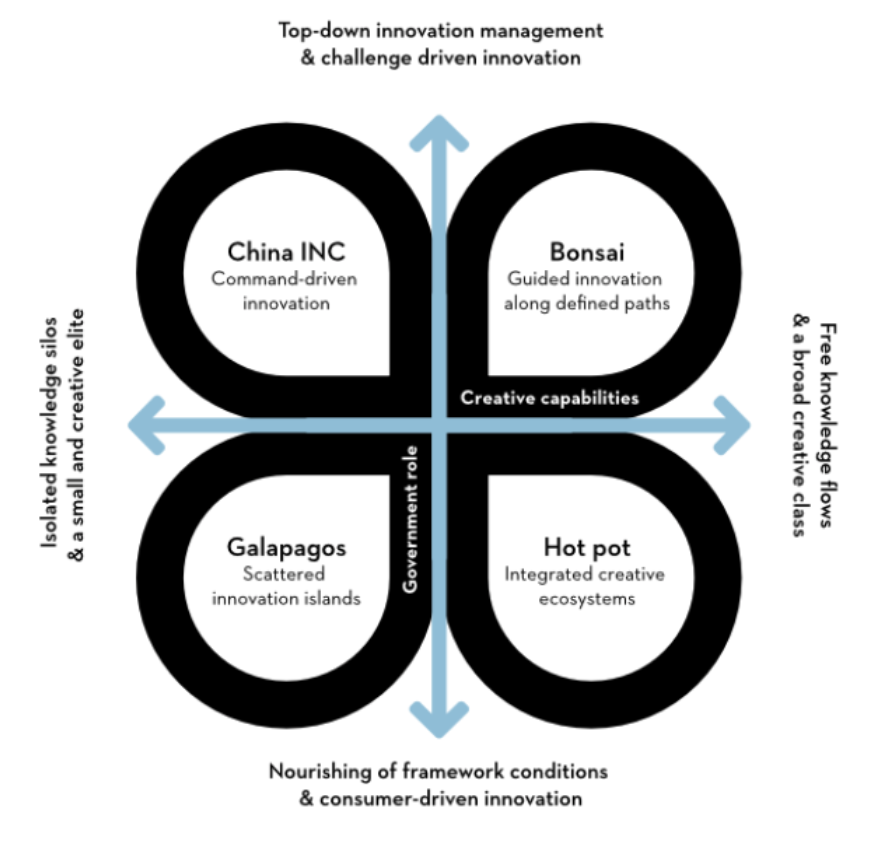
Figure 1 The four scenarios developed describe alternative futures for China's innovation landscape depending on the role of the state and creative capabilities.
The two key uncertainties underpinning the scenarios were the role of the state and society in the innovation system and knowledge flows and the creative capacity of the country. In terms of creativity, the report saw two possible developments: either towards more open information flows and a broadening of an entrepreneurial and creative class. Or, alternatively, a move towards the isolation of expertise and a creative elite. For the role of society, the possible outcomes were, on the one hand, a movement towards a state that saw its role as a nurturing regulator that sets the conditions for consumer-driven innovation. On the other hand, there were signals towards a more top-down driven innovation direction based on clear challenges to be solved. In this case, even a quick overview of the developments since 2017 can provide a fairly clear picture of the direction in which China has evolved.
Uncertainty 1: The role of the state and society
First and foremost, we can state that as far as Chinese society is concerned, there has been no development towards democracy. A more authoritarian turn is evident with the
• the draconian crackdown on citizens during the pandemic,
• the treatment of the Uyghur minority,
• the reaction to the protests in Hong Kong,
• the ruling Communist Party's crackdown on academic freedom; and
• Xi Jingping abandoning the previous practice of only serving two terms as General Secretary along with the removal of the ceiling on the length of time a president can hold the office.
This has also been reflected in the development of the innovative digital and consumer-oriented economy. The rapid growth of the digital economy and the realization of the significance of data flows prompted the Chinese government to tighten its cyber legislation several times in the 2010s. It was implemented in batches to avoid what is called "disorderly capital expansion"[i], including in the regulation of gaming. The ongoing statements on "disorderly capital" clearly indicated that it was not interested in innovation focused on satisfying the desires of a free market, a rhetorical reminder that the ruling party has not shifted its fundamental view of the role of markets.
2020 also saw increased pressure on the tech sector to fall in line, with heavy-handed crackdowns on major Chinese consumer-facing tech companies such as Tencent, Didi, ANT-group and ByteDance. Demands for state ownership have been tightened[ii] and the latest five-year plan for China clearly emphasizes the desire to see digitalization and sustainability transformation in line with "socialism with Chinese characteristics" as interpreted by Xi Jingping. The plan also makes it clear that it wants to see several major shifts in areas such as energy transition, digitalization and increased food production and that the broad society is expected to stand up and help solve these challenges.
Uncertainty 2: Creativity and knowledge flows
The next dimension of uncertainty concerns the flow of ideas and knowledge. An indicator of how this has developed could be the development of the co-working trend in the country. If the number of shared offices and spaces where businesses meet increases, this could be expected to be followed by more exchange of ideas, freer creativity and broader participation in innovation. Until the pandemic, China saw strong growth in co-working offices in parts of the country – one study shows almost explosive growth between 2012-2019. But on the other hand, there is widespread internet censorship and very little press freedom.
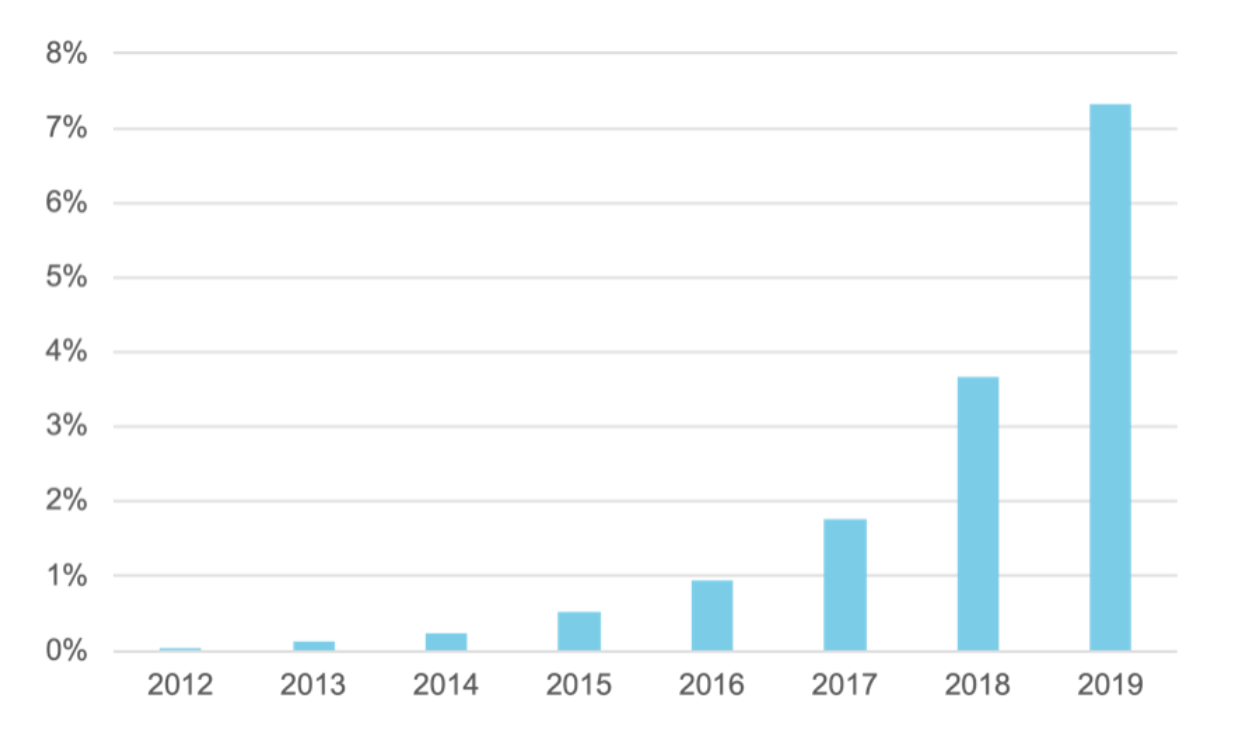
Figure 2 Share of different co-working solutions in Chinese office space according to study by Frost & Sullivan on Forward Intelligence.
Growing suspicion of Western influences, visible in the markings against universities focusing on political science and law[iii], the restriction of Western technologies, and the great firewall separating the Chinese internet from the West also point to a movement towards free knowledge flows. According to analyses of China's innovation and startup landscape, the growing domestic market and increased risks of being perceived as Western-oriented have created incentives to turn inward and operate along state and party lines rather than thinking aloud and freely with global peers.
What seems to be happening, with the crackdown on the technology sector, the establishment of a sophisticated censorship apparatus, repression of dissidents and ambitious goals for further development, is that clearer boundaries are being set for companies and individuals to operate and think within.
Overall assessment – clear movement towards "China AB"
The increasingly controlling, top-down and clearly challenge-driven state in China, which sets up a line of conflict between the state, the party and the people on the one hand, and on the other a "disorderly capital" that can go just about anywhere, means that we can be said to have moved towards the scenario known as China Inc or Kina AB in Swedish.
In this scenario, the state takes a clearer role in pointing out the direction, directing funds with a focus on mega projects in the national interest and at the expense of "fair play" towards foreign actors and companies. In the 2017 report, the following thoughts were put forward on what a direction towards China AB could mean.
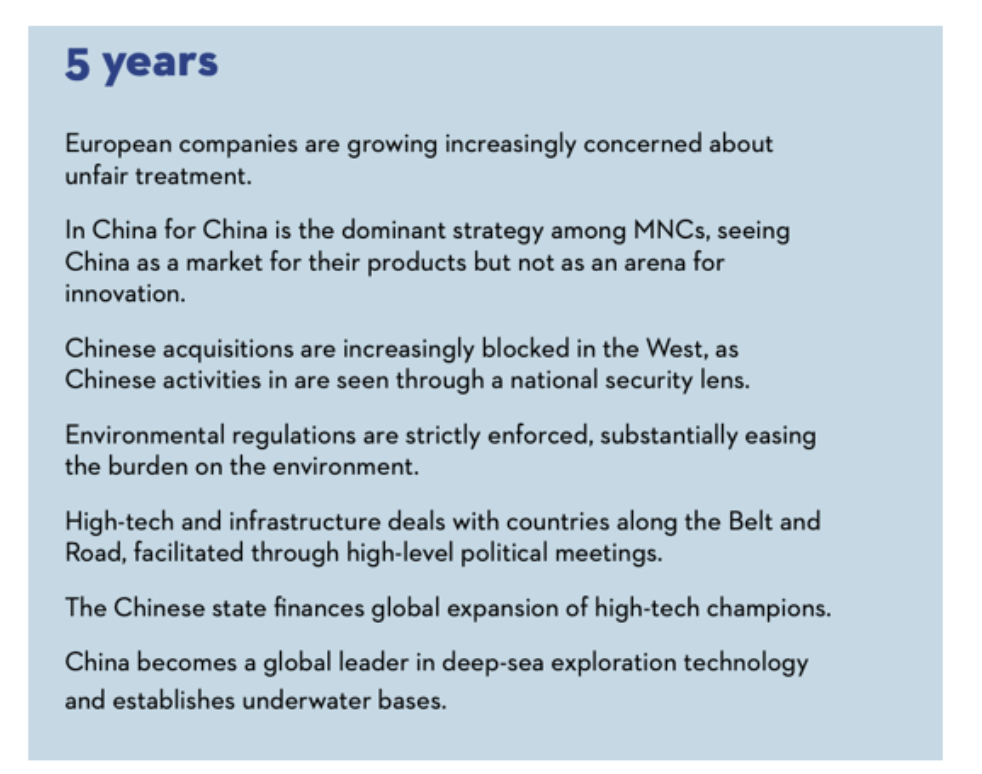
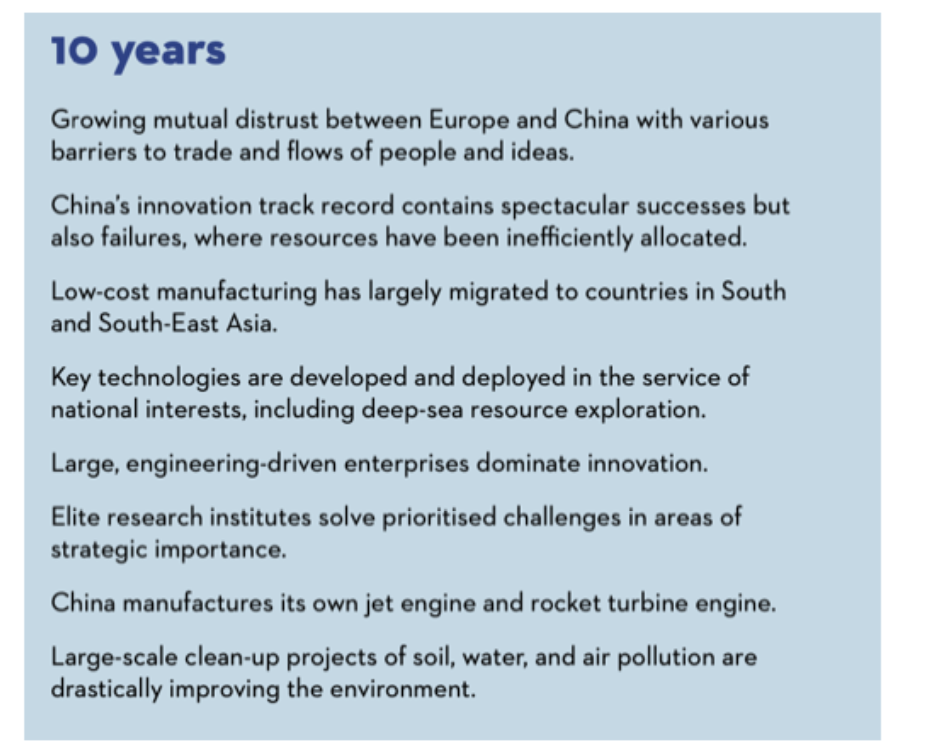
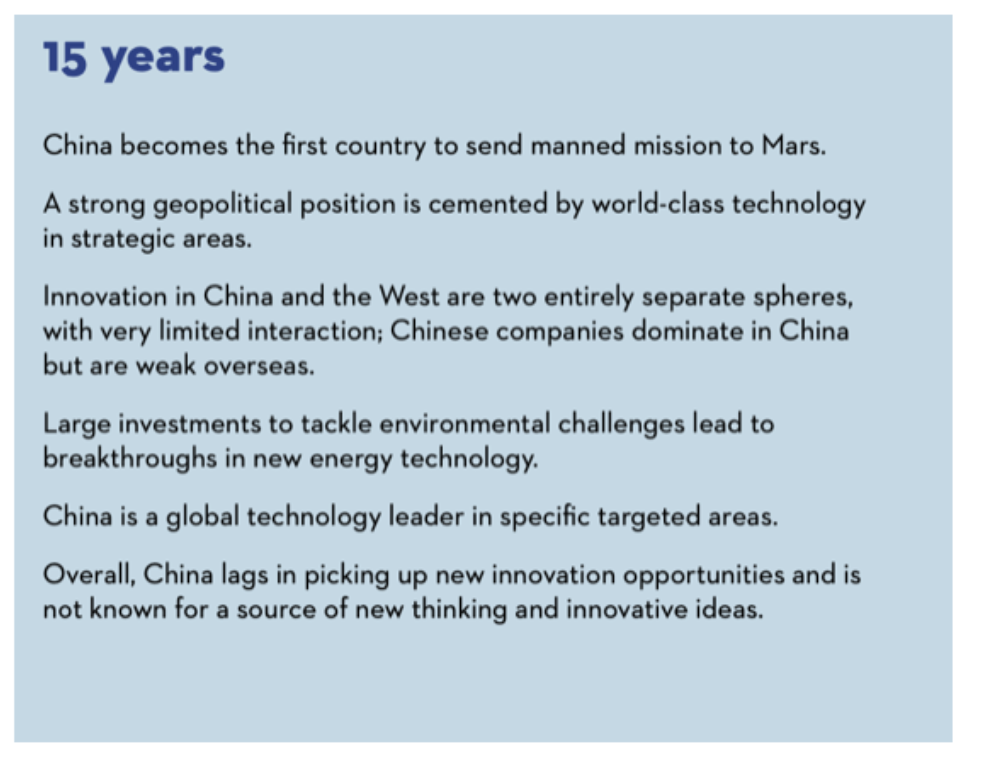
Several of these expected consequences can be recognized in today's news feeds. From the expansion of the Belt and Road, space projects and deep-sea exploration, to the separation of innovation systems and the fracas with European investors.
Going forward – important to cooperate but growing political & power schism
The major focus of the 2017 report was the conditions for cooperation between Europe and China. Today, a mutual suspicion and value gap appears to be one of the major obstacles to deeper cooperation. All in all, we can see that the 2017 report was written at the end of an optimistic period for Europe-China relations and that the development has been towards an even more extrapolated scenario than the report described.
The Dragonstar report also identified possible areas of cooperation that become more important between China and Europe under the different scenarios.

The underlying idea was that these areas are well suited to large-scale ventures or span areas subject to international regulation. What we see now is that in regards to infrastructure, space and quantum computing, they have become a source of competition rather than cooperation. In the case of environmental regulation, infection control and new developments in biological technology, it is clear that cooperation is needed as these are issues of concern to the global community. The need to agree on global issues remains, but the requirements have increased to be able to reach consensus without being on the same ideological basis and with more clearly expressed conflicting geopolitical interests.
The future requires robust strategies – scenarios are a tool to get there
China and the EU are the world's second and third largest economies and together account for over a third of the world's combined GDP. Despite growing scepticism and suspicion, they will not be able to ignore each other. On truly global issues such as greenhouse gas emissions, there is also direct interdependence. This means that both authorities and companies need to develop knowledge and strategies to deal with the continued development towards a more centralized China AB that works clearly according to its own agenda.
China's great importance means that even those who do not have direct investments in the country can benefit from deeper knowledge and business intelligence that follows technical, social and political developments in the country. A robust China strategy thus needs to address everything from comparative advantages to the domestic market's geopolitical concerns, public relations situation and the broader external landscape.
In this text, we have shown how scenarios can anticipate possible developments and provide the conditions for strategic dialogue that takes account of alternative outcomes. If the scenario work has thus been taken all the way, the organization has already created an overall insight and preparedness for what will be important in the various scenarios. Working through "China AB" in 2017 meant taking a serious look at the signals that were already visible at the time about a "China that puts China first" and having a picture of what this means for their own operations. In this way, mental preparedness can be created for uncertain futures.
Do you want to know more about how your business can explore future uncertainties and how different scenarios may affect you? Contact Johanna Danielsson, CEO Kairos Future, or Axel Gruvaeus, Senior Analyst.
[i] See Reuters: https://www.reuters.com/article/china-economy-idUSKBN2FV0UR
[ii] See news reporting on the impact on the technology industry and the so-called "Golden Stocks" which are now expected to keep the technology sector closer to the government's view of what good development is:
https://thechinaproject.com/2021/08/02/chinas-big-tech-crackdown-a-guide/
https://asia.nikkei.com/Business/China-tech/Just-how-over-is-China-s-tech-crackdown-It-depends-who-you-ask
https://www.economist.com/business/2023/01/19/chinas-tech-crackdown-starts-to-ease
https://www.ft.com/content/65e60815-c5a0-4c4a-bcec-4af0f76462de
[iii] Reported on by Global Times här: https://www.globaltimes.cn/page/202302/1286308.shtml
